Making your own pasta isn’t difficult, and I was reminded whilst making these ravioli just how satisfying, relaxing and therapeutic it can be. I realized I seriously don’t make pasta often enough and so I hope to make an effort to make it more often. You will taste the difference when you make your own pasta: plus the bonus with making pasta ripiena (filled pasta) is that you can customize it with any filling you like.
While making ravioli may be relatively easy, it’s the kind of technique that you perfect and develop with time. Once you get the knack (after doing it once, I promise), you can get creative with fillings and sauces, and don’t forget to try different shapes (there are stamps in all shapes and sizes).
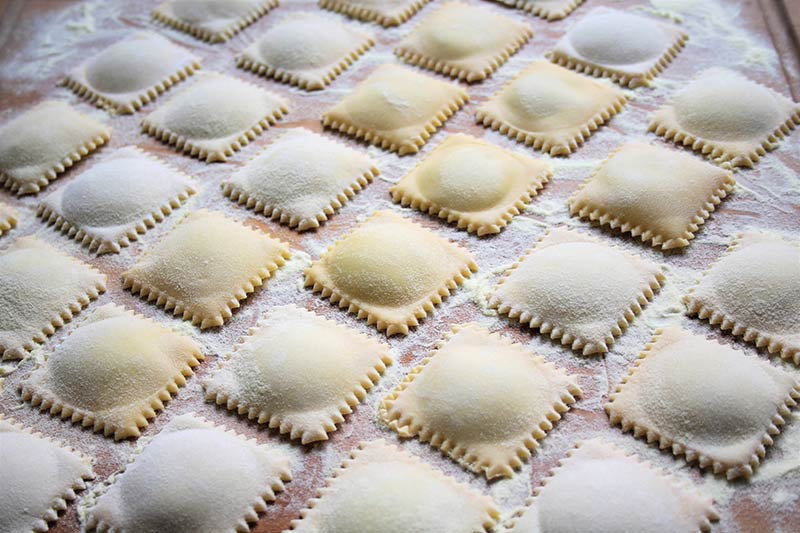
Perfectly shaped and cut, these ravioli are entirely made by hand © | Toni Brancatisano
I have used semola in this recipe instead of an egg pasta made just with plain “00” flour. The semola gives the pasta more structure – which is perfect for filled pastas -or you might use it in a recipe for fettuccine or trofie. Depending on how much you add, it also makes the surface of the pasta slightly rougher. Semola is different from semolina though, so don’t think they are one in the same. Semolina is closer to corn meal than flour. The Italian semola is very fine, as it is rimacinata (twice milled). Please do not stress if your local supermarket doesn’t have any, you can easily make the pasta dough with 300g “00” flour and 3 eggs.
The important thing to remember when making pasta is to work the dough well with “elbow grease” and passion, and then to let it rest for an hour before using it.
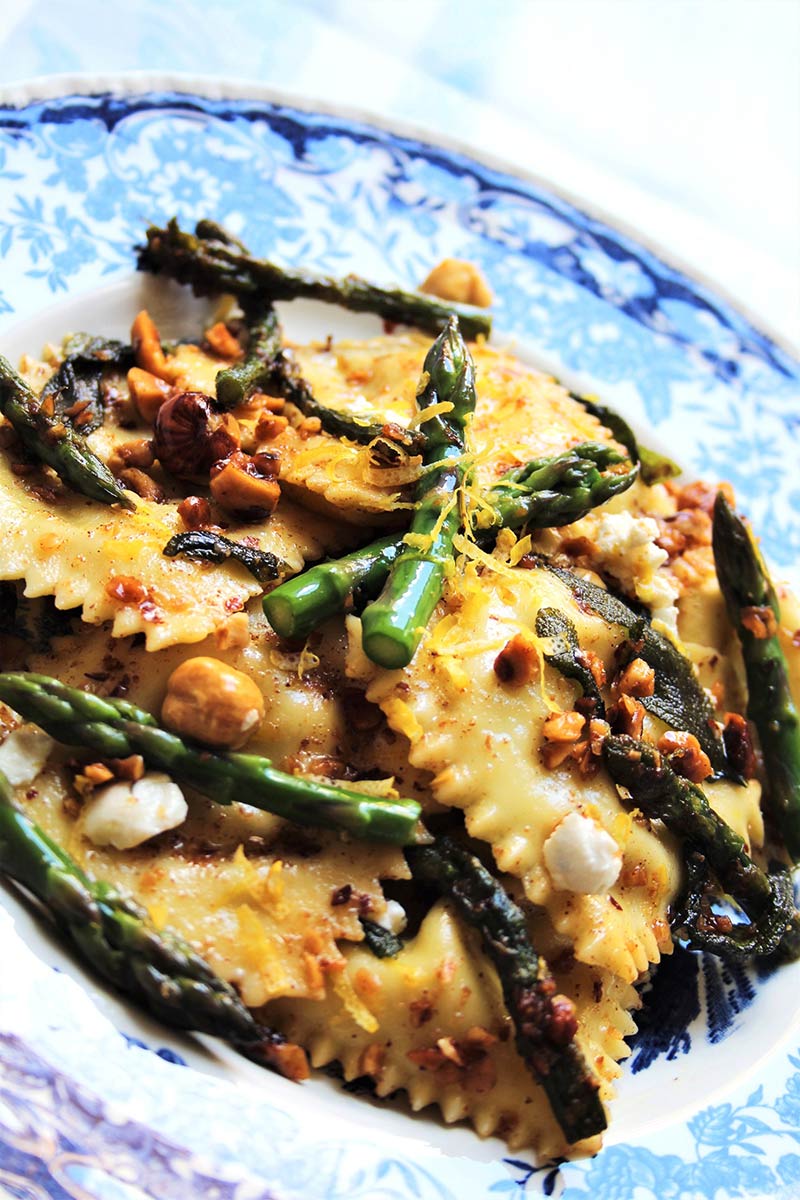
© | Toni Brancatisano
Homemade pasta cannot be kept for long because of its egg content. Instead of refrigerating it, (especially if you make too much for one sitting), it is best to freeze it. You can then cook it, throwing it into a pot of boiling, salted water directly from the freezer. It’s certainly a great idea to dedicate a day to making pasta, and then to freeze it in portion sizes. This is such a godsend when you come home tired from work and you have little energy to spend too much time in the kitchen.
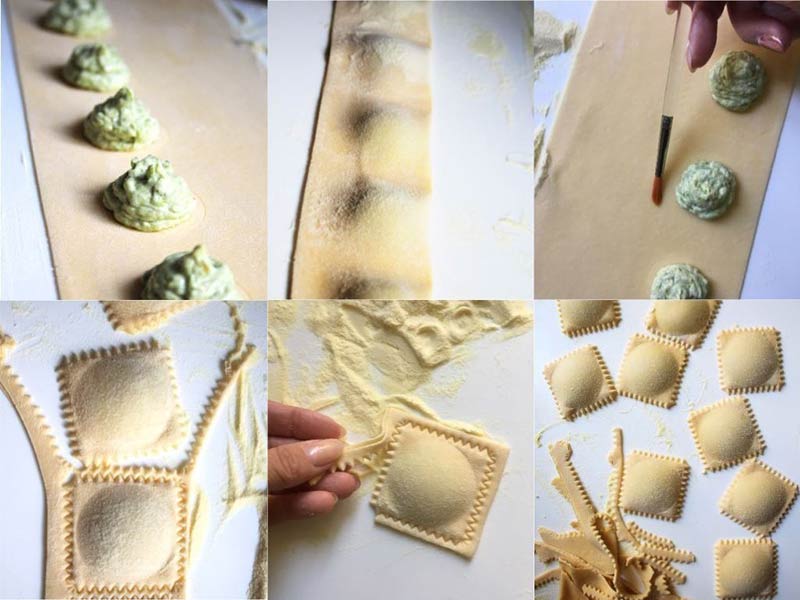
The various passages to make and shape the perfect ravioli © | Toni Brancatisano
PASTA ALL’ UOVO (FRESH PASTA) IDEAL FOR RAVIOLI
• 7 oz of plain “00” flour
• 3.5 oz durum wheat semola
• 3 eggs
• pinch of salt
1. Sift the flours on a clean work surface (you can also do this in a large bowl), form a mound and make a well in the centre.
2. Break the eggs and pour into the well. Add the salt.
3. Use a fork or your fingertips to incorporate the flour gradually into the eggs. I use a fork to start beating the eggs, slowly drawing the surrounding flour into the egg until the mixture becomes too thick to continue working with a fork. Then continue with your hands and ensure you use the dough to pick up any remaining bits of egg or flour on the work bench.
4. Add a little more flour if the dough feels too sticky. Knead lightly to create a ball that keeps together. Clean the work bench and wash your hands.
5. Lightly flour the work surface and start to knead the dough. Use the heel of one hand and work the dough for 10 minutes or so until the dough becomes smooth and elastic. (Note the time pasta is kneaded depends on the type of dough, but more importantly on who is doing the kneading: big, strong chefs will get the work done in half the time it takes me.
6. Wrap the dough in plastic kitchen wrap and allow to rest for at least an hour. My pasta rested for over an hour, (because lunch and life happened) but use this time to prepare the ravioli filling.
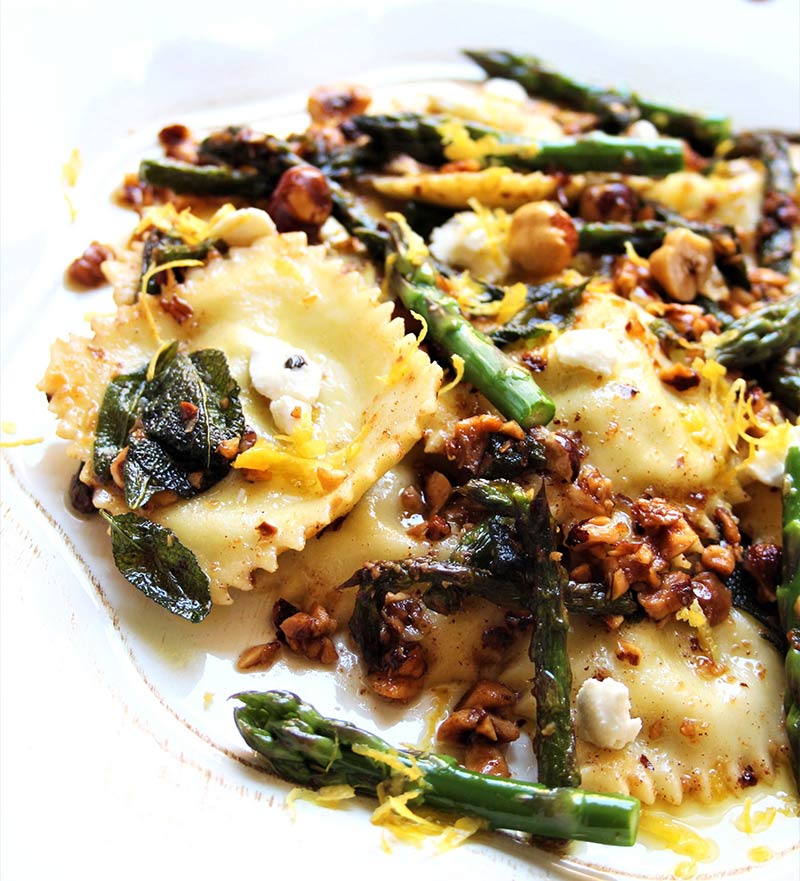
© | Toni Brancatisano
ASPARAGUS AND GOAT CHEESE FILLING
• 14 oz asparagus
• 500ml water
• salt and pepper
• 7 oz soft goat cheese
• 7 oz ricotta (sheep or goat ricotta)
• 2 oz Pecorino Romano, finely grated
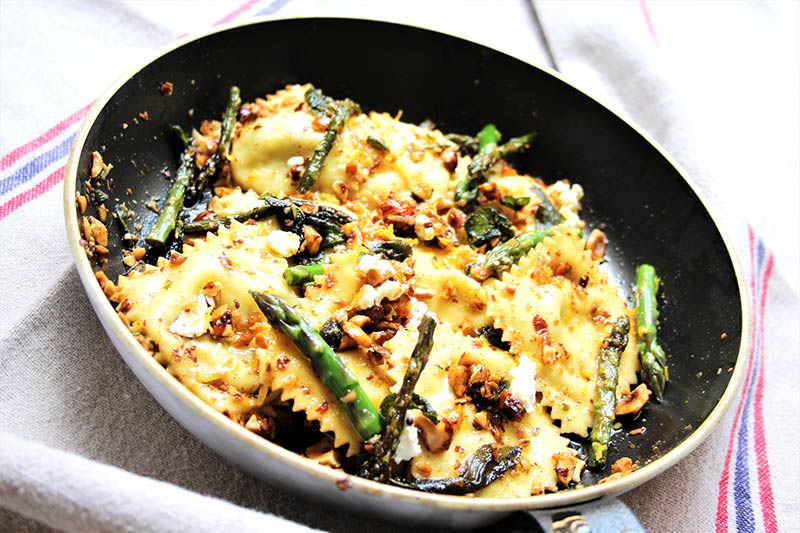
© | Toni Brancatisano
DIRECTIONS
1. Wash the asparagus. Remove the asparagus tips, cutting about 2 inches and set aside. Snap off the tough ends and chop the remaining asparagus stems into small pieces.
2. Add the asparagus to a shallow frying pan with salt and pepper, then cover with 500ml of water.
3. Bring to the boil, then reduce the heat and allow to simmer until the asparagus are soft, and all the water has evaporated. Put them aside to cool.
4. Add the cold asparagus to a mini food processor and process until you have a smooth purée.
5. In a bowl mix together the goat cheese, the ricotta and the Pecorino Romano. Add some freshly cracked black pepper. Stir in the purées asparagus. Taste the filling and add a little salt if required. If you think it needs more salt, add more Pecorino instead.
6. Transfer filling into a piping bag and refrigerate until you have your pasta ready.
MAKING RAVIOLI
Using a 45mm square ravioli stamp, I made 42 ravioli with the quantities from the above pasta recipe.
1. Remove the pasta dough from the plastic and cut off a piece. Re-wrap the remaining pasta dough to prevent it drying out. Dust the work surface with some flour, and use your hands to flatten the pasta.
2. Set the pasta machine at its widest setting. Very lightly dust either side of the pasta with a little flour and pass the dough through the pasta machine. Repeat another two times (I use the pasta-roller attachment for my KitchenAid mixer).
3. Fold the pasta in 3. Fold either end into the middle. Pass this through the pasta machine one more time on the widest setting.
4. Click the machine to the next setting and pass the pasta through twice, repeating the pasta folding after each time the pasta passes through. Aim to have the pasta sheets the same width as the pasta machine.
5. Click the machine to the next setting, this time passing the pasta dough through just once each time. (and no more folding). Lightly dust the pasta sheet on both sides with a little flour every time you pass it through.
6. I stopped at No. 5 on my KitchenAid pasta machine, but you should know that for ravioli (or tortellini) you should roll the pasta dough to the point where you can see your hand or lines of newsprint through it.
7. Start making the ravioli as soon as you have your pasta sheet to the desired thickness. Pasta dries quickly, so make the ravioli until you have used up all the pasta, then begin with the pasta machine again with another piece of pasta. Wrap any pasta scraps in plastic wrap so you can knead it to use again.
8. Place the prepared pasta sheet on a well-floured work surface. Pipe about a heaped teaspoon of filling at 2 inches intervals along one half lengthwise of the pasta sheet. I used the ravioli stamp to lightly indent the pasta so I had a guide as to the space I would need between each one. Note that ravioli stamps come in different sizes.
9. Brush lightly around the filling with water – this helps keep the ravioli sealed. Fold over the pasta sheet and then press with your fingers around the filling to seal the pasta together. Another method is to have two rolled sheets of pasta , and top the bottom one with filling with the second pasta sheet. Do whatever works best for you.
10. Use the ravioli stamp, a glass, or even a cookie cutter and cut out your ravioli, ensuring the filling is in the centre of each raviolo. Transfer the ravioli to a tray dusted with semola.
11. Continue with the remaining pasta and filling.
BURNT BUTTER, SAGE AND HAZELNUT SAUCE
• 7 oz salted butter
• 20 fresh sage leaves
• 5 oz whole hazelnuts, roasted and chopped
• Asparagus tips
1. Using a medium size non-stick frying pan, place the pan on a low-medium heat and add the butter and sage. Melt the butter slowly.
2. Blanche the Asparagus tips (this means to plunge the asparagus into boiling water for a short amount of time before transferring it to an ice bath, which quickly stops the cooking, and maintains a vibrant green color).
3. Turn the heat up to medium-high, bring the butter to a violent simmer, add the hazelnuts to the hot butter, and cook until the butter is golden brown and the sage leaves are crisp.
4. Add the asparagus tips and toss through butter.
THE FINAL DISH
• lemon zest and goat cheese to serve
1. Bring a large saucepan of water to the boil and add 1-2 tablespoons of salt.
2. Add ravioli to boiling water and cook for 8 minutes. Do not stir because the ravioli may break apart. Test if the ravioli is ready by taking a bite after fishing one out with a slotted spoon. (Your ravioli may need 10 minutes, or it may need less than 8 minutes. It all depends on the thickness of the pasta).
3. Remove ravioli with a slotted spoon and add directly to the frying pan with the burnt butter sauce. Toss over a medium heat quickly and ensure all the ravioli has been coated with the butter.
4. Serve with a sprinkling of freshly grated lemon zest and a few dots of goat cheese.
Fare la pasta non è difficile, e mentre facevo questi ravioli mi sono ricordata di quanto possa essere soddisfacente, rilassante e terapeutico. Mi sono seriamente resa conto che non faccio la pasta abbastanza spesso e quindi spero di riuscire a farla più frequentemente. Gusterete la differenza quando preparerete voi stessi la pasta: il bonus, con la pasta ripiena, è che la si può personalizzare con qualsiasi ripieno che piace. Se preparare i ravioli può essere relativamente facile, la tecnica si perfeziona e si sviluppa con il tempo. Una volta imparato il trucco (dopo averlo fatto una volta, lo assicuro), potrete essere creativi con ripieni e salse e non dimenticate di provare forme diverse (ci sono stampi di tutte le forme e dimensioni).
Ho usato semola in questa ricetta invece della pasta all’uovo fatta solo con farina “00” normale. La semola conferisce alla pasta più struttura – che è perfetta per paste ripiene – o la si può usare in una ricetta per fettuccine o trofie. A seconda di quanto se ne aggiunge, essa rende la superficie della pasta leggermente più ruvida. La semola è diversa dal semolino, quindi non pensate che siano la stessa cosa. Il semolino è più vicino alla farina di mais che alla farina. La semola italiana è molto fine, in quanto è rimacinata (macinata due volte). Non stressate il vostro supermercato locale se non ne ha, si può facilmente fare l’impasto con 300 gr. di farina “00” e 3 uova.
La cosa importante da ricordare quando si prepara la pasta è quella di lavorare bene l’impasto con “olio di gomito” e passione, e quindi di lasciarlo riposare per un’ora prima di usarlo.
La pasta fatta in casa non può essere conservata a lungo a causa del suo contenuto di uova. Invece di refrigerarla, (specialmente se se ne fa troppa), è meglio congelarla. La potrete quindi cucinare, gettandola in una pentola di acqua salata bollente direttamente dal freezer. È sicuramente una buona idea dedicare una giornata alla preparazione della pasta e poi congelarla in porzioni. Questa è una vera manna dal cielo quando si torna a casa stanchi dal lavoro e si ha poca energia per passare troppo tempo in cucina.
PASTA (FRESCA) ALL’ UOVO IDEALE PER I RAVIOLI
• 7 once di farina “00” normale
• 3,5 once di semola di grano duro
• 3 uova
• un pizzico di sale
1. Setacciare le farine su una superficie di lavoro pulita (si può fare anche in una grande ciotola), formare un cumulo e creare un pozzo al centro.
2. Rompere le uova e versarle nel pozzo. Aggiungere il sale.
3. Utilizzare una forchetta o la punta delle dita per incorporare gradualmente la farina nelle uova. Io uso una forchetta per iniziare a battere le uova, mettendo lentamente la farina circostante nell’uovo fino a quando la miscela diventa troppo spessa per continuare a lavorarla con una forchetta. Quindi continuare con le mani e utilizzare l’impasto per raccogliere eventuali pezzi rimanenti di uova o farina sul banco di lavoro.
4. Aggiungere un po’ più di farina se l’impasto risulta troppo appiccicoso. Impastare leggermente per creare una palla che si mantenga insieme. Pulire il banco di lavoro e lavarsi le mani.
5. Infarinare leggermente il piano di lavoro e iniziare a lavorare l’impasto. Usare il palmo di una mano e lavorare l’impasto per 10 minuti o fino a quando l’impasto diventa liscio ed elastico. (Nota: il tempo in cui la pasta viene preparata dipende dal tipo di impasto, ma soprattutto da chi sta facendo l’impasto: grandi e forti cuochi faranno il lavoro in metà tempo).
6. Avvolgere l’impasto in un involucro di plastica da cucina e lasciare riposare per almeno un’ora. La mia pasta ha riposato per oltre un’ora, (perché c’erano il pranzo e altro da fare) ma usate questo tempo per preparare il ripieno dei ravioli.
RIPIENO DI FORMAGGIO DI CAPRA E ASPARAGI
• 14 once di asparagi
• 500 ml di acqua
• sale e pepe
• 7 once di formaggio di capra morbido
• 7 once di ricotta (ricotta di pecora o di capra)
• 2 once di Pecorino Romano, finemente grattugiato
1. Lavare gli asparagi. Rimuovere le punte degli asparagi, tagliando circa 2 pollici e mettere da parte. Eliminate le estremità resistenti e tagliate a pezzetti i restanti steli degli asparagi.
2. Aggiungere gli asparagi a una padella poco profonda con sale e pepe, quindi coprire con 500 ml di acqua.
3. Portare a ebollizione, quindi ridurre il calore e lasciare cuocere a fuoco lento fino a quando gli asparagi sono morbidi e tutta l’acqua è evaporata. Metterli da parte a raffreddare.
4. Aggiungere gli asparagi freddi a un mini robot da cucina e processare fino a ottenere una purea liscia.
5. In una ciotola mescolare insieme il formaggio di capra, la ricotta e il pecorino romano. Aggiungere un po’ di pepe nero appena macinato. Mescolare la purè di asparagi. Assaggiare il ripieno e aggiungere un po’ di sale se necessario. Se pensate che abbia bisogno di più sale, aggiungete invece più Pecorino.
6. Trasferire il composto in una sac à poche e conservare in frigorifero fino a quando la pasta è pronta.
FARE I RAVIOLI
Usando lo stampo per un raviolo quadrato da 45mm, ho realizzato 42 ravioli con le quantità della precedente ricetta di pasta.
1. Rimuovere la pasta dalla plastica e tagliare un pezzo. Ri-avvolgere la pasta rimanente per evitare che si asciughi. Spolverare il piano di lavoro con un po’ di farina e usare le mani per appiattire la pasta.
2. Impostare la macchina per la pasta nella sua impostazione più ampia. Spolverare leggermente entrambi i lati della pasta con un po’ di farina e passare l’impasto attraverso la macchina per la pasta. Ripetere altre due volte (io uso l’accessorio del rullo per pasta per il mio mixer KitchenAid).
3. Piegare la pasta in 3. Piegare l’altra estremità al centro. Passarla attraverso la macchina per la pasta ancora una volta sull’impostazione più ampia.
4. Impostare la macchina sulla successiva impostazione e passare la pasta due volte, ripetendo la piegatura della pasta dopo ogni volta che si passa la pasta. Cercate di avere i fogli di pasta della stessa larghezza della macchina della pasta.
5. Passate all’impostazione successiva, passando questa volta l’impasto della pasta solo una volta ogni volta (e non più piegandola). Spolverare leggermente la sfoglia su entrambi i lati con un po’ di farina ogni volta che la si passa.
6. Mi sono fermata al n° 5 della mia macchina per la pasta KitchenAid, ma sappiate che per i ravioli (o i tortellini) dovrete rotolare l’impasto fino al punto in cui potete vedere la mano o le righe sulla carta da giornale attraverso di essa.
7. Iniziare a preparare i ravioli non appena il foglio di pasta raggiunge lo spessore desiderato. La pasta si asciuga velocemente, quindi preparare i ravioli fino a quando non avrete esaurito tutta la pasta, poi iniziate di nuovo con la pasta con un altro pezzo di pasta. Avvolgete gli scarti di pasta nell’involucro di plastica in modo da poterli utilizzare nuovamente.
8. Posizionare il foglio di pasta preparato su un piano di lavoro ben infarinato. Mettete circa un cucchiaino colmo di ripieno a intervalli di 2 pollici lungo una metà del foglio di pasta. Ho usato il timbro per ravioli per far rientrare leggermente la pasta, così ho avuto una guida dello spazio che avrei avuto tra ognuno di essi. Si noti che gli stampi per ravioli sono disponibili in diverse dimensioni.
9. Spennellate leggermente attorno al ripieno con acqua – questo aiuta a tenere i ravioli chiusi. Piegare il foglio di pasta e premere con le dita intorno al ripieno per sigillare la pasta insieme. Un altro metodo prevede di avere due fogli di pasta arrotolata e coprire quello con il ripieno con il secondo foglio di pasta. Fate come vi è più comodo.
10. Usate lo stampo dei ravioli, un bicchiere o anche un cutter per biscotti e tagliate i ravioli, assicurandovi che il ripieno sia al centro di ogni raviolo. Trasferire i ravioli in un vassoio spolverato di semola.
11. Continuare con la pasta e il ripieno rimanenti.
SALSA AL BURRO, SALVIA E NOCCIOLE
• 7 once di burro salato
• 20 foglie di salvia fresca
• 5 once di nocciole intere, arrostite e tritate
• punte di asparagi
1. Utilizzando una padella antiaderente di medie dimensioni, posizionare la padella a fuoco medio-basso e aggiungere il burro e la salvia. Sciogliere lentamente il burro.
2. Scottate le punte degli asparagi (questo significa immergere gli asparagi in acqua bollente per un breve periodo prima di trasferirli in un bagno di ghiaccio, che interrompe rapidamente la cottura e mantiene un vivace colore verde).
3. Alzare il fuoco a medio-alto, portare il burro a bollire lentamente, aggiungere le nocciole al burro caldo e far cuocere fino a quando il burro diventa marrone dorato e le foglie di salvia sono croccanti.
4. Aggiungere le punte degli asparagi e buttarle nel burro.
IL PIATTO FINALE
• scorza di limone e formaggio di capra per servire
1. Portare ad ebollizione una grande casseruola d’acqua e aggiungere 1-2 cucchiai di sale.
2. Aggiungere i ravioli all’acqua bollente e cuocere per 8 minuti. Non mescolare perché i ravioli potrebbero rompersi. Provare se i ravioli sono pronti morsicandoli dopo averne pescato uno con un mestolo forato. (I ravioli potrebbero richiedere 10 minuti o potrebbero essere necessari meno di 8 minuti. Tutto dipende dallo spessore della pasta).
3. Rimuovere i ravioli con un mestolo forato e metterli direttamente nella padella con la salsa al burro. Passare velocemente a fuoco medio e assicurarsi che tutti i ravioli siano stati rivestiti con il burro.
4. Servire con una spolverata di scorza di limone appena grattugiata e qualche pezzetto di formaggio di capra.




































